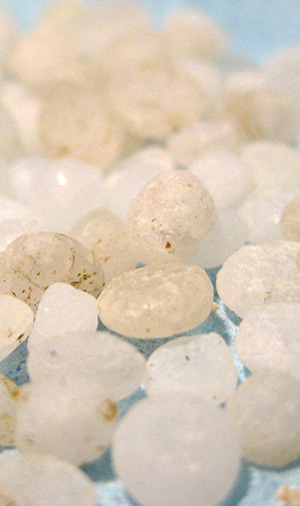
The burgeoning problem of microplastics, itty-bitty plastic pieces in our water
While plastic has been a water pollution concern in for awhile, it is only recently that researchers have started to take a hard look at problem of “microplastics” in inland waters. And when they looked, they found them to be widespread throughout the Great Lakes. So just what are microplastics, and what they do?
Microplastics are tiny particles of plastic that range in size from 5 millimeters on the large end (about the size of a pencil eraser) to micrometers (less than the width of a human hair). They enter the environment in a variety of ways, like through the gradual breakdown of plastic-containing litter like bottles or bags into smaller and smaller sizes. Additionally, there are some products that are specifically designed as microplastics, like plastic “microbeads” used in cosmetics and cleaning products. These products get washed right down the drain, and are difficult to remove from the water by sanitation systems because of their buoyancy and resistance to coagulation (a process where particles are made to clump together, so they can be settled out of the wastewater stream).
Since microplastics aren’t biodegradable, once they get into the environment they stick around for a long time. This means that there are many opportunities for them to be taken in by aquatic organisms, and researchers have found them in everything from tiny invertebrates to large fish. More research is still needed on how these microplastics end up impacting the organisms that ingest them, but it is clear that they have the potential to disrupt digestive systems, and decreasing feeding by taking up space in those digestive systems.
There are also potential chemical impacts from microplastics, which may be an even larger concern. For example, most plastics contain additives, like BPA, to give them certain properties. If these additives leach out of ingested microplastics, they could cause significant impacts for individual organisms or even their offspring. Additionally, microplastics may act as a pathway for toxic chemicals to be concentrated from the water and enter into the foodweb. This is because microplastics can act as sponges for persistent organic pollutants (like pesticides and PCBs) or other chemical pollutants in the water. When the microplastics are then eaten or otherwise taken in by aquatic organisms, those pollutants may then be released into the organisms. This becomes an even larger concern with pollutants that accumulate in the organisms and then “biomagnify” up to much higher concentrations as animals higher up the food chain eat lots of contaminated organisms that are lower down.
Fortunately, some (but not all) major cosmetics companies have agreed to eventually phase out microbeads. Until then, here’s how you can help keep them out of the environment:
- Follow the three Rs: Reduce your plastic use, reuse plastic products when possible, and be sure to recycle them when you’re done.
- Don’t buy them: Avoid using products that contain plastic microbeads; pay particular attention to face and body washes or scrubs, toothpastes and hand soaps.
- Check the ingredients: Avoid “polyethylene” or “polypropylene, even in products that don’t explicitly state that they contain exfoliants.
- Go natural: Opt for products that contain natural ingredients, such as oatmeal, sea salt, sugar, fruit pits or pumice.
